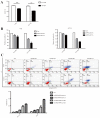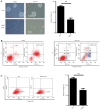Fenretinide targeting of human colon cancer sphere cells through cell cycle regulation and stress-responsive activities
- PMID: 30250604
- PMCID: PMC6144862
- DOI: 10.3892/ol.2018.9296
Fenretinide targeting of human colon cancer sphere cells through cell cycle regulation and stress-responsive activities
Abstract
Cancer stem cells (CSCs) are considered to be the main cause of chemoresistance and the resultant low survival rate of patients with cancer. N-(4-hydroxyphenyl)-retinamide, known as fenretinide or 4HPR, is a synthetic derivative of all-trans-retinoic acid. It is a promising anticancer agent, has minimal side effects and synergizes with other anticancer agents to reinforce their anticancer efficacy. The present study investigated whether fenretinide eliminated colon sphere cells. HT29 and HCT116 cells incubated in low-serum culture medium were more sensitive to fenretinide treatment than those incubated in full-serum medium. Colon spheres formed in serum-free medium demonstrated stem-like characteristics. The percentage of cluster of differentiation (CD) 44+ cells was significantly higher in sphere cells compared with parental cells. Sphere cells also demonstrated increased tumorigenic ability in non-obese diabetic/severe combined immunodeficiency mice. Fenretinide inhibited the formation of colon spheres in HT29 and HCT116 cells. Microarray, cell cycle and reverse transcription-quantitative polymerase chain reaction analysis revealed that fenretinide induced genes associated with cell cycle regulation and the stress response in fenretinide-treated HT29 sphere cells. To the best of our knowledge, the present study was the first to investigate the effect of fenretinide on colon stem cells. Fenretinide was demonstrated to preferentially target colon sphere cells, which may possess certain stem-like characteristics. These results are an important addition to the current knowledge concerning fenretinide, and provide a foundation for its clinical application in the treatment of cancer.
Keywords: cancer stem cells; cell cycle; cell stress; colon cancer; fenretinide; sphere.
Figures





References
LinkOut - more resources
Full Text Sources
Other Literature Sources
Molecular Biology Databases
